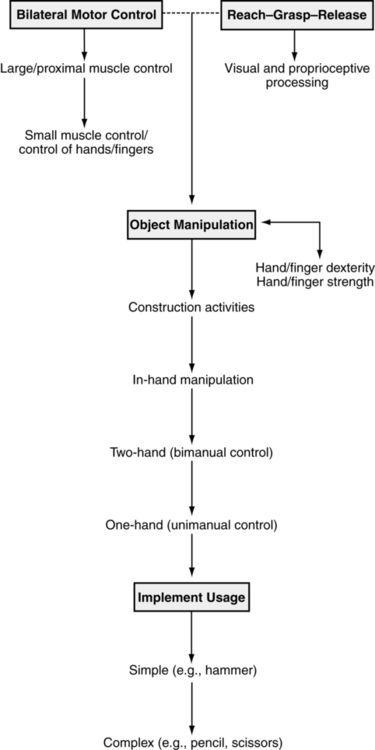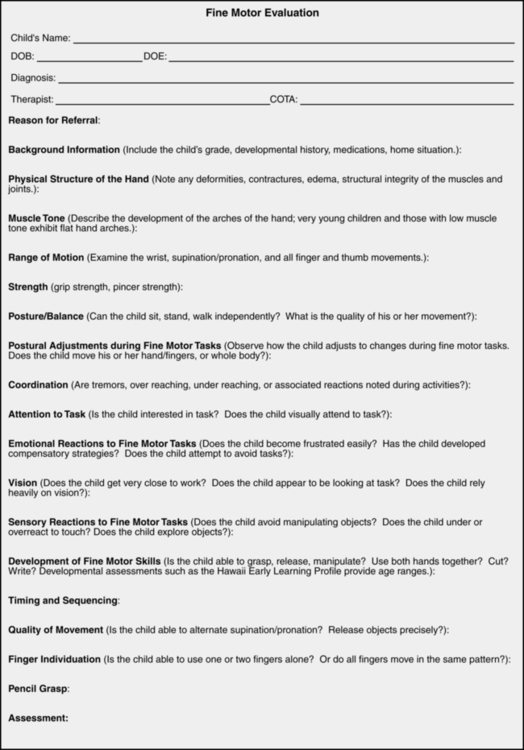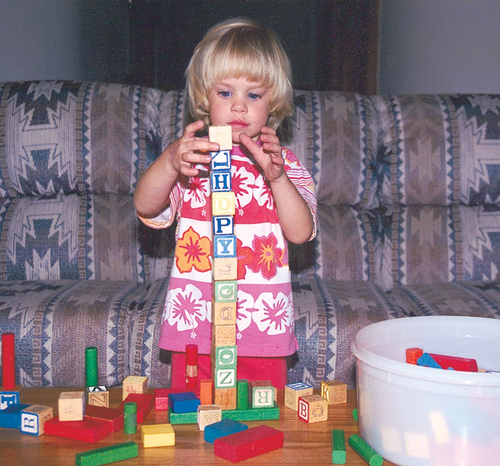23 After studying this chapter, the reader will be able to accomplish the following: • Describe fine motor development in typically developing children • Identify common problems of children with fine motor control deficiencies • Describe techniques to promote fine motor functioning in children • Understand basic motor learning principles • Describe how basic motor learning principles relate to occupational therapy intervention Fine motor development is generally defined as the ability to use the eyes, hands, and fingers together in carrying out precise movements that are necessary for performing a variety of daily activities. These movements range from those involved in coloring, drawing, and writing to pasting, cutting, and the manipulation of small objects and implements. Other terms commonly used interchangeably with fine motor development include eye–hand coordination, visuomotor coordination, and distal extremity control.39–41 In understanding and working with the development of fine motor skills, it is important to be aware of several elements that make up the foundation of fine motor skill development; these include bilateral motor control, reaching/grasping, object manipulation, and implement usage.7,18,20,21,28,32,35,39,40,42 Bilateral motor control includes large and small (proximal and distal) muscle control; reaching/grasping is, in part, an extension of proximal and distal control and is the key component in grasping and in the manipulation of objects. Refined object manipulation that follows is built on the foregoing elements and involves construction and in-hand manipulation activities. Construction activities include stacking blocks, putting simple puzzle pieces together, and putting pegs into a pegboard, among others (Figure 23-1). In-hand manipulation activities involve moving objects within the hand (translation) and include adjusting a toy or object in the hand (shift), rotating an object in the hand (rotation), or picking up multiple objects. Precision grasping and releasing are critical to all of these activities. Finally, tool use, or the use of implements, evolves with and, in part, from earlier experiences with object manipulation skills. Overall, the development of fine motor skills is an ongoing, integrated, and complex process. A schema that depicts the relationships among the various elements involved in fine motor development is shown in Figure 23-2 and discussed in more detail below. The term small muscle control refers to the control or use of the small muscle masses of the wrist, hands, and fingers to grasp, hold, and manipulate objects. Small muscle, or distal, control typically follows and builds on the development of a minimum of control of the large, more proximal muscles of the trunk, shoulders, and arms. The development of proximal stability of the large muscles supports the mobility of the distal muscles of the wrist, hand, and fingers. Small muscle, distal control allows the child to carry out more precise, adaptive movements that involve intricate manipulation and/or the use of objects and implements. Small muscle control requires adequate hand and finger strength and dexterity; these aspects of hand function are assessed and included in fine motor OT interventions (Figure 23-3). Object manipulation may be thought of as the manual control of objects (i.e., the ability to manipulate or use an object in a variety of desired ways). Object manipulation may involve what some refer to as construction activities and in-hand manipulation activities; both can be bimanual or unimanual. Examples of construction activities include putting puzzles together, building towers out of building blocks, making shapes with Lego, and putting pegs into a pegboard. Examples of in-hand manipulation activities include turning the lid of a jar, picking up multiple objects, and others in which the thumb plays a prominent role (Figure 23-4). The skillful manipulation of objects involves, in particular, the ability to control the actions of individual fingers and groups of fingers (manual dexterity). It also requires that the arm and hand work together to control or use the object (bimanual control); this is often referred to as the arm–hand linkage system and is the basic foundation for the subsequent development of implement usage skills.5,6,11–15,19,22,28,29,39,40 Generally, adults and children with typical development or function exhibit patterns of force production and modification that allow them to create and apply the force needed to manipulate objects effectively. Therefore, adequate strength, along with the ability to produce appropriate force and apply that force when it is needed, is integral to fine motor control and development. If the amount of force is inadequate or the application or use of that force is poorly timed, the object may slip or slide, and the skillful and efficient use or manipulation of the object may be hindered. Producing force involves, among other things, the activation of appropriate muscles and the proper timing of the contraction of those muscles to produce the force needed for effective object manipulation. Force production and modification of that force are integral to all types and forms of object manipulation. For example, appropriate levels and timing of force are needed to lift an object; here, the amount of force produced should be equal to the weight of the object to be lifted. This requires accurate anticipation of the weight of the object and the ability to plan the movement to produce that force. Another example is the transport, or movement, of an object from one place to another (e.g., picking up pegs and putting them into a pegboard). This involves upward, downward, and horizontal movements and varying the force as needed. Another important component is the ability to respond appropriately to variables such as changes in object position and slippage of the object; this is referred to as grip reflex, or the timing and application of appropriate force to adapt to changes in object position.16,17,23,38,41 Adequate muscular strength of the hands and fingers is important to produce the force needed to carry out fine motor tasks with skill and efficiency.40 The following are some examples of activities that may be helpful in strength development: • Pinch putty between the thumb and individual fingers in sequence from the index to the little finger, and vice versa. • Push slowly into a putty ball; hold each finger extended. • Press cookie cutter into Play-Doh or another similar substance. • Hold putty or soft ball in the palm of the hand and squeeze. • Squeeze a turkey baster or other plastic item. • Crumble sheets of paper into a ball. • Twist or wring putty or other material with palm toward and away from the body. • Squeeze water out of a sponge or other soft material. • Hold playing cards between two fingers; try to knock the cards out of the finger grasp • Holding a weight in one hand, with the palm down and forearm supported, flex and extend the wrist. • Use rubber bands as resistance to finger and wrist movements. Several overlapping trends or dimensions of behavior need to be considered in assessing the development of fine motor object manipulation skills.6,14,39,40 The manipulation skill indicators include the development of hand control (how and for what purpose the child uses the hands), spatial–temporal accuracy (skills that require judging the space and timing of the action of the hands), and self-help skills. Examples of the general developmental sequence of some of these behaviors are given in Box 23-1.
Motor control: fine motor skills
Foundations of fine motor skill development

Bilateral motor control, small muscle control, and object manipulation
Development of object manipulation skills
Force production and object manipulation skills
Activities to promote strength development
Developmental progression for object manipulation
![]()
Stay updated, free articles. Join our Telegram channel

Full access? Get Clinical Tree


Motor control: fine motor skills



